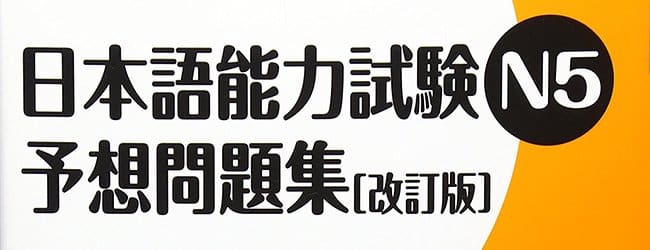The JLPT can sometimes come down to how well you can answer questions about Japanese. As I talked about in my earlier review, test anxiety and just, in general, how well you can test, can greatly affect your score. You should at least try to take one practice test before the big day, and if you have time, or are on the edge, you might benefit from taking multiple tests.
And taking tests like this can really help you discover your weak points and strong points and adjust your studying accordingly. There is nothing more terrible than that feeling you get when you are in the middle of the test and realize you haven’t done enough reading or listening practice. Especially when, with just a little bit of practice, it is quite possible to boost that score.
I talked about J-Publishing’s solution a few weeks ago, and there is also a freely available practice test for the N5 as well as a full-sized workbook. All of these offer very good on level practice for the test, so that you can get a good feel for what to expect. 日本語能力試験N5予想問題集 offers some more practice.
Overall Structure
This book is not exactly a practice test. It is more a book full of practice questions for the different sections of the exam. One thing to note is that this book came out right about the same time as the new tests came out, ~2010. At that time there hadn’t been enough tests administered or other material published to get a good feel for the level of the test or what the new questions were going to be like.
There are also simple answer explanations in the back of the book in English, Korean, and Chinese. These are pretty straightforward explanations, although a few of them include illustrations to explain more difficult concepts. The listening scripts are also included without any translations.
Like I said above, there aren’t clear sets of practice tests, but rather a collection of practice questions. Here is a break down of how many questions for each section:
| Test Section | Type of Question | In the Book | Actual Test |
|---|---|---|---|
| Vocabulary | Kanji Reading (Choose the correct hiragana for the kanji) |
26 | 12 |
| Orthography (Choose the correct kanji for the hiragana) |
26 | 8 | |
| Contextually-defined Expressions (Choose the word that fits in the sentence) |
26 | 10 | |
| Paraphrases (Choose the sentence that has a similar meaning) |
23 | 5 | |
| Grammar | Sentential Grammar I (Choose correct grammar form) |
31 | 16 |
| Sentential Grammar II (Unscramble the sentences) |
30 | 5 | |
| Text Grammar (Choose the correct word in the paragraph) |
35 | 5 | |
| Reading | Comprehension (Short passages) | 7 | 3 |
| Comprehension (Mid-size passages) | 10 | 2 | |
| Information retrieval | 5 | 1 | |
| Listening | Task-based comprehension | 15 | 7 |
| Point comprehension | 14 | 6 | |
| Utterance expressions | 20 | 5 | |
| Quick response | 25 | 6 |
There are enough questions for at least two practice tests, and there are a good number of extra questions for some of the tougher types of questions.
Good Points
This book contains a great group of questions and includes a good number of some of the tougher questions. For example, there are 30 sentential grammar II questions, the equivalent of 6 practice tests. This is a huge amount of practice for these particularly difficult to get used to questions. There is also a good amount of reading questions that you can go over to improve your reading comprehension skills.
There are also decent answer explanations in Korean, Chinese and English for all the questions in the book. There aren’t a lot of details to these, but they give you enough to get the main idea and figure out why a particular answer is right or wrong.
The answer book is removable, so you don’t have to lug it around. You can also use it as quick reference when going over your answers. You don’t have to hold your place and turn all the way to the back of the book.
Bad Points
This book came out just when the test came out, so the questions are a little more difficult than the real test. In parts of the reading and listening, they use N4 grammar and vocabulary. Some people might see this as an advantage as it kind of over prepares you and gets your ready to encounter things you might not know, which could very well happen on the test. However, with the minimal answer explanations this might be a little troublesome if you are not working with a teacher or tutor you can ask questions to.
This is just a raw list of questions. There is little explanation of each part of the test, and there is no mention of strategies that you can employ to maximize your score. As long as you have a good idea of what the test is like or you have another similar book that can fill in the details, this lack of information might prove to be confusing and may ultimately leave you unprepared as to what is on the test.
Again no MP3s, just one CD with all the audio tracks on it. This could cause problems if you are without a CD player. Also, generally speaking, there is less listening practice in this drill book then in others. You basically get enough for around 2 practice tests and some change, so if you are looking to hone your listening skills, this might not be the book for you.
Overall
This book offers a lot of good practice, but it isn’t the end all be all. There are other books to pick up before making your way to this one. However, if you have worked your way through the other books and are looking for a little more practice with the questions before the test, this might be it for you. Or, if you feel like the other material is too easy and want to get a jump start on studying for N4 you could use this as a good transition since the level is a little higher than N5.
In my opinion the J-Research Practice tests are a lot better at giving you a proper practice test that will help you get a good idea of what the actual test will be like. It provides a lot more explanations and details about the actual JLPT.











